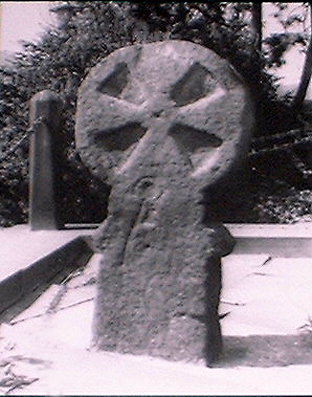Cross: OS Grid Reference – SD 890 423
Not hard to locate. From Colne head up to Foulridge via the skipton Road and as you get to the middle of the town ask find the cenotaph just off the main road.
Archaeology & History

The Maiden or Tailor’s Cross has at least two old traditions attached to the site, which local historians think originate from the Civil War period. The first tells of a Royalist tailor who – sensibly – refused to make uniforms for Oliver Cromwell’s traitorous soldiers; but as a result, the poor tailor was shot by the troops and the remains of his body were placed over the old stone cross as a warning to his fellow workers. If you look closely on the cross you can see a crude carving of what looks like a pair of scissors or shears, and it is this carved symbol which has seemingly given birth to the legend of the tailor. There may, of course, be some truth in the story; but the carved shears is more likely an old Masonic carving – though quite who did it and when isn’t known.
The other legend is the one which apparently gave birth to the title of the Maiden’s Cross. It tells of a certain Margaret Burnard whose husband went into battle (on the side of the treacherous Cromwell), but who agreed before he set out that she should wait for him for to return by the side of the old cross; and this she did each and every day, waiting for her husband, Robert, to come back from the Civil War. But he was one of the many who died in the Battle of Marston Moor. However, Margaret refused to accept his death and returned to the cross each evening to their agreed meeting place. The story goes that Margaret herself herself was eventually killed by Royalist soldiers – and her body was buried at the cross where she had so often waited in vain.
It seems likely that this old cross originally replaced an old ‘heathen’ site in Foulridge. Several such spots were known here, though virtually nothing now remains. But notices of these sites will appear on TNA in the near future.
References:
- Oldland, F., The Story of Foulridge, PHCL: Pendle 1990.
© Paul Bennett, The Northern Antiquarian
The map could not be loaded. Please contact the site owner.
Originally refered to as THE SALTERS CROSS now stands at the top of Lowther Lane. It was removed from its former site to facilitate house building in the 1920’s, then being sited in what is now the garden of Lakeside House (SD 890 416), its pedestal still lies buried in that spot.
The head is carved out on both faces, and incised below the head are a pair of pincers. The later not only recalls the Passion of Christ but also the ‘pinch of salt’. Originally the shaft would have been of greater length, but like many others was damaged during the Civil Wars period. Local names for the Salters Cross, Taylor’s Cross & Maiden’s Cross, originate from that time, along with the requisite legends attached to the names.
The roadway by which the cross formerly stood is an ols saltway, part of a mid-Pennine network of roads that were established in pre-Conquest times reaching their greatest use in the 16th & 17th centuries. The Foulridge Salt Road was part of a route that ran from the salterns at Northwich, via Manchester, Colne & Skipton, to Knaresborough. The hamlet of Salterforth, two miles to the north, recalls this ancient trackway.
The Salt Roads radiated from Cheshire, and modern investigation has revealed the existence of a mediaeval industry and its extraordinary transport network of tracks, bridges, resting places and selling locations. The Foulridge Cross could have marked one of the larrer (a salt-pie).
Paul is right in stating that the cross could have a pre-Christian origin. The area that the cross was originally sites is called ‘Burwains'(burial site/sacred grove? a house C17 nearby is called ‘Hobstones’) and stands below Noyna Hill (Noon Hill).
We need to look at this site more fully.
At the moment I am listing the positions of ’round-headed’ crosses in the search for a context to place them in historically.